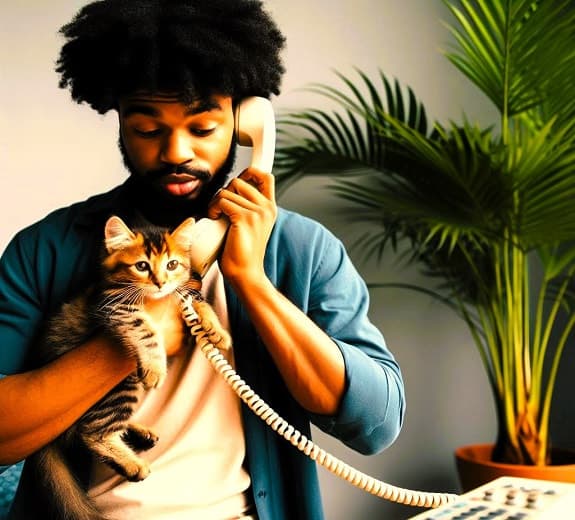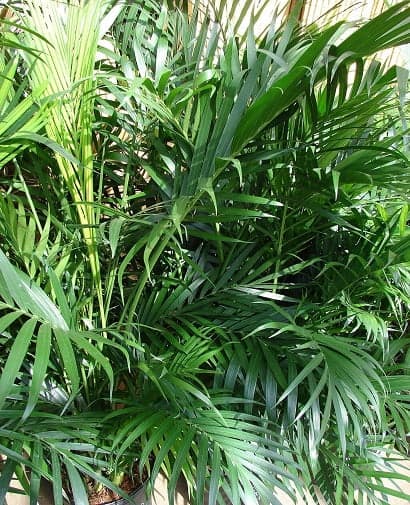- Home
- Palm Tree Problems
- Palms Toxic for Cats?
Any Palm Trees Toxic to Cats?
Are you asking: Is a palm tree toxic to cats?
Well, snuggle with your purring friend, and let's find out! We're glad to try to help our fellow cat lovers!
As devoted guardians of our furry friends, we want our homes to be their safe havens. Only natural you're wondering about potential dangers lurking in your backyard or house.
At Mission: Palm Trees
Palm lovers can soothe their palm-related searches and concerns. Our articles are intended to inform, while having fun, easily Finding What You Want or Need. Without unneeded shoptalk & tiring endless research. We Research For You!
Are Palm Trees Toxic for Cats?
FIRST THINGS FIRST
The overall answer is that, generally speaking, palm trees aren't toxic to cats.
Many common types of palm trees, are safe for cats. That includes Palm Houseplants like the Areca Palm, & Kentia Palm.
Some have heard the Parlor Palm might be toxic. Well, for this Palm - It Depends>
That info, we're thinking, might be a relief for you. Especially if you have a mini tropical paradise in your home. And concerned about palm tree toxicity to cats.
But hold your horses! The plot thickens. Right, palms aren't generally dangerous for cats. But some palm-like plants are very much the villains in our cat toxicity scale tale.

Is a Sago Palm Toxic to Pets?
The prime example of a dangerous palm imposter is the (Cycas revoluta) Sago Palm!
- Even though named as a palm, it isn't in the palm family. So it's not a true palm.
- Instead it's a cycad.
- An entirely different Phylum from the palms. Way up the biological hierarchy, three classifications higher than Families. So beware of cycads!
This ancient plant is grouped into gymnosperm seed plants. They even predate the dinosaurs. Think of them as the living fossils of the plant world.
 Sago palm at the Florida Museum of Natural History.
Sago palm at the Florida Museum of Natural History.Photo: Michael Rivera - CC BY-SA 4.0
Sago Palm's Toxicity to Cats
For cats, age doesn't necessarily bring wisdom.
- Remember the cat's curiosity often gets the better of them.
- You know that saying about the end result of feline curiosity - right?
The Sago Palm isn't friendly to our cats. In fact, they're extremely toxic to felines. All parts of the plant are poisonous. Sago palm seeds (the nuts of the plant) are the most toxic part.
 This Plant is Toxic to Pets - Beware!
This Plant is Toxic to Pets - Beware!Photo: Paige Filler @ Flickr & Edited by MPT
The Deadly Sago Palm Toxin
The active toxin is cycasin, which all cycads contain.
That substance can lead to liver failure for cats. If your pet eats even the smallest amount, kitty can become severely sick. The worst-case scenario will lead to death.
This makes Sago Palms one of the most dangerous plants for your cat.
Newest Palm Article
-
San Diego palm trees: History, Species, and Their SoCal Charm
Fascinated by San Diego palm trees? Discover their history, types, and why they're a staple of SoCal’s SD neighborhood scenery to inspire your landscape design.
Investigating Toxicity in My Cat
Recognizing if your cat has swallowed a part of the Sago Palm is top priority.
- Symptoms often appear within 12 hours of a cat getting involved with it
- Eating any of its parts.
 Sadly, this poor cat is very ill. 😢 Did it get into a toxic plant?
Sadly, this poor cat is very ill. 😢 Did it get into a toxic plant?Photo: William Whyte @Flickr - SA 4.0
Plant Poison Symptoms in a Cat
If you suspect they've eaten some part of a Sago, watch for one or more of these possible warning signs:
- Vomiting, drooling & lack of appetite and/or diarrhea
- Lethargy, with wobbly walking and/or indications of abdominal pain
- Jaundice is Seen in Cats. Yellowish coloring when viewing kitty's mucous membranes. Plus skin areas, especially those lacking fur. Like inside their ears.
Any of these symptom could finally escalate to seizures, or even coma. Hopefully it hasn't gone that far!
What to Do if Your Cat Has Eaten Toxic Plants
 Unsure About Your Cat Getting Into a Toxic Palm?
Unsure About Your Cat Getting Into a Toxic Palm?Call Your Veterinarian for Advice.
What action should you take?
If you suspect a Sago Palm run-in with your cat.
- First Step: immediately Contact a Veterinarian.
- If you' be taking your feline to the Vet, bring a sample from the plant. So your cat's veterinarian can see exactly what's been swallowed.
The more information they have, the better. It will all be helpful for diagnosing & treating your feline friend.
Other Palm-Like Plants Harmful to Cats
If you say, "I don't have a Sago Palm, so my cat will be safe, right?"
Nope, slow down!
There's another palm-like plant criminal on the loose. It's the Cardboard Palm (Zamia furfuracea). Again, it's not a true palm but a cycad in the Zamiaceae family. Like the Sago Palm, all of its parts are toxic to cats. It produces the same nasty toxin, cycasin.
What do you think about taking some cat safety preventive measures?
We advise keeping this palm faker out of your cat's reach. But we all know how difficult that would be! Better to keep it out of your house altogether. It's always better to be safe than sorry!😗
We ourselves, like to research & use cat-friendly palm options. We think you agree with that approach.
Any Other Plants Bad for Cats?
Remember, though, even non-toxic plants can cause irritations or allergic reactions in some cats.
Monitor your cat's behavior around new palm plants. Watch for signs of distress, because you'll want to call your vet.
To ensure our homes are safe havens for our cats, we need to be knowledgeable about the potential threats. This includes understanding which plants are palm trees dangerous to pets and which are safe.
Advice from your experienced vet is best. For being a lifesaver.
You can also check reliable resources, like the ASPCA. They maintain a comprehensive list of toxic and non-toxic plants for cats. We've checked it, as a very useful guide.
ANY NONTOXIC PALMS?
We've talked about the bad guys, but what about the good guys? Can any palm trees coexist peacefully with our cats? Absolutely!
The Majesty Palm (Ravenea rivularis) is a good houseplant.
Can be grown inside - or outside, too!
These palms can beautify your home without causing harm to pets. They're both nontoxic to cats.
The Butterfly Palm (Dypsis lutescens) is also called Areca Palm & Golden Cane Palm. It's suitable as an Indoor Palm - But watch carefully for spider mites.
The Cat Palm (Chamaedorea cataractarum) is sometimes called the Cataract Palm. Placed by a sunny window, it'll be fine.
 The Butterfly Palm Tree
The Butterfly Palm TreePhoto: Dinesh Valke - SA - 4.0
 The Cat Palm, is Safe Around Cats!
The Cat Palm, is Safe Around Cats!Photo: Forest & Kim Starr - CC BY 4.0
Palm Tree Toxicity to Cats Takeaways
As conscientious cat parents, our concern for their well-being is paramount.
We can now be sure our palmy plants are as friendly as we are. Demonstrating our love for our feline friends. Being informed about the possibility of a palm tree toxic to cats is one way to express that sentiment.
In the end, the key is to be vigilant and knowledgeable. Keeping those purrs echoing! And remember, when in doubt, it's always best to consult a professional. But meanwhile, we hope we helped you out!






